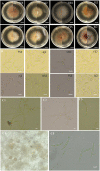Identification and pathogenicity of Fusarium spp. associated with tea wilt in Zhejiang Province, China
- PMID: 38281024
- PMCID: PMC10821546
- DOI: 10.1186/s12866-023-03174-4
Identification and pathogenicity of Fusarium spp. associated with tea wilt in Zhejiang Province, China
Abstract
Background: Tea is one of the most widely consumed beverages in the world, with significant economic and cultural value. However, tea production faces many challenges due to various biotic and abiotic stresses, among which fungal diseases are particularly devastating.
Results: To understand the identity and pathogenicity of isolates recovered from tea plants with symptoms of wilt, phylogenetic analyses and pathogenicity assays were conducted. Isolates were characterized to the species level by sequencing the ITS, tef-1α, tub2 and rpb2 sequences and morphology. Four Fusarium species were identified: Fusarium fujikuroi, Fusarium solani, Fusarium oxysporum, and Fusarium concentricum. The pathogenicity of the Fusarium isolates was evaluated on 1-year-old tea plants, whereby F. fujikuroi OS3 and OS4 strains were found to be the most virulent on tea.
Conclusions: To the best of our knowledge, this is the first report of tea rot caused by F. fujikuroi in the world. This provides the foundation for the identification and control of wilt disease in tea plants.
Keywords: Fusarium; Fusarium fujikuroi; Pathogenicity; Tea wilt.
© 2024. The Author(s).
Conflict of interest statement
Competing interests. The authors declare no competing interests.
Figures




Similar articles
-
First report of Fusarium oxysporum causing wilt on Perilla frutescens in China.Plant Dis. 2025 Jul 7. doi: 10.1094/PDIS-03-25-0467-PDN. Online ahead of print. Plant Dis. 2025. PMID: 40622348
-
Identification, Pathogenicity, and Genetic Diversity of Fusarium spp. Associated with Maize Sheath Rot in Heilongjiang Province, China.Int J Mol Sci. 2022 Sep 16;23(18):10821. doi: 10.3390/ijms231810821. Int J Mol Sci. 2022. PMID: 36142733 Free PMC article.
-
Morphological characterization, pathogenicity screening, and molecular identification of Fusarium spp. isolates causing post-flowering stalk rot in maize.Front Microbiol. 2023 Mar 31;14:1121781. doi: 10.3389/fmicb.2023.1121781. eCollection 2023. Front Microbiol. 2023. PMID: 37065162 Free PMC article.
-
Green tea (Camellia sinensis) for the prevention of cancer.Cochrane Database Syst Rev. 2009 Jul 8;2009(3):CD005004. doi: 10.1002/14651858.CD005004.pub2. Cochrane Database Syst Rev. 2009. Update in: Cochrane Database Syst Rev. 2020 Mar 2;3:CD005004. doi: 10.1002/14651858.CD005004.pub3. PMID: 19588362 Free PMC article. Updated.
-
Fusarium species causing eumycetoma: Report of two cases and comprehensive review of the literature.Mycoses. 2017 Mar;60(3):204-212. doi: 10.1111/myc.12590. Epub 2016 Dec 7. Mycoses. 2017. PMID: 27928841
Cited by
-
A Novel Strain Burkholderia theae GS2Y Exhibits Strong Biocontrol Potential Against Fungal Diseases in Tea Plants (Camellia sinensis).Cells. 2024 Oct 25;13(21):1768. doi: 10.3390/cells13211768. Cells. 2024. PMID: 39513875 Free PMC article.
-
FGSE02, a Novel Secreted Protein in Fusarium graminearum FG-12, Leads to Cell Death in Plant Tissues and Modulates Fungal Virulence.J Fungi (Basel). 2025 May 21;11(5):397. doi: 10.3390/jof11050397. J Fungi (Basel). 2025. PMID: 40422731 Free PMC article.
References
-
- Food and Agriculture Organization of the United Nations. (2022). FAOSTAT. http://www.fao.org/faostat/en/#data/QC.
-
- Zhang X, Yi J, Huo D, et al. First report of Fusarium proliferatum causing leaf spot on tea plants in Jiangxi Province, China. Plant Dis. 2023;7:2220. doi: 10.1094/PDIS-04-22-0896-PDN. - DOI
Publication types
MeSH terms
Substances
Grants and funding
LinkOut - more resources
Full Text Sources
Miscellaneous

